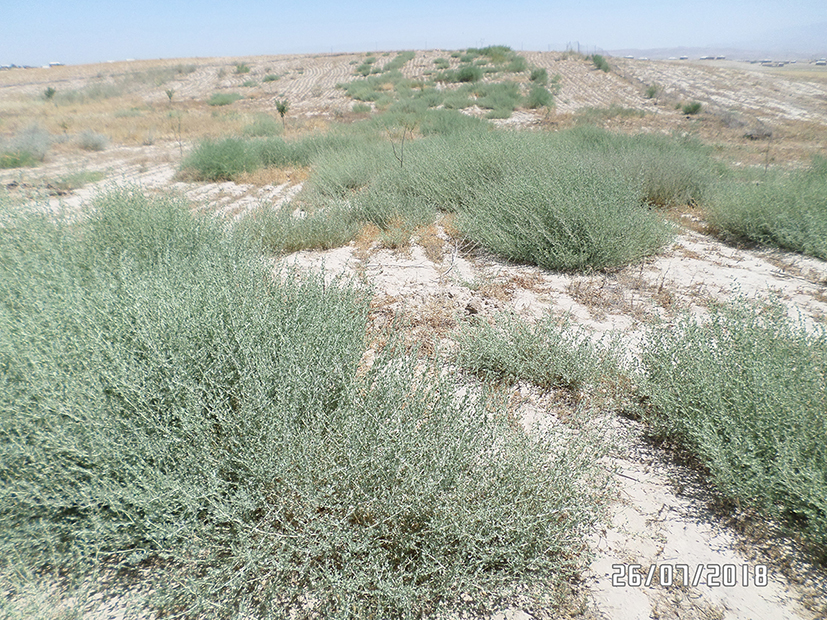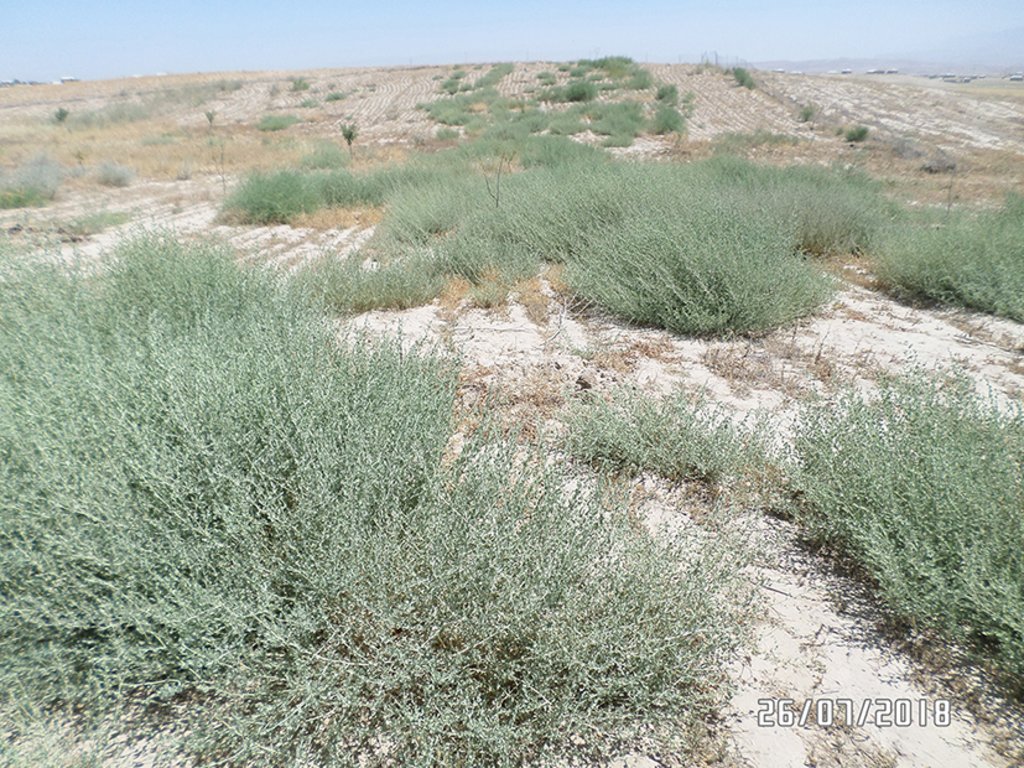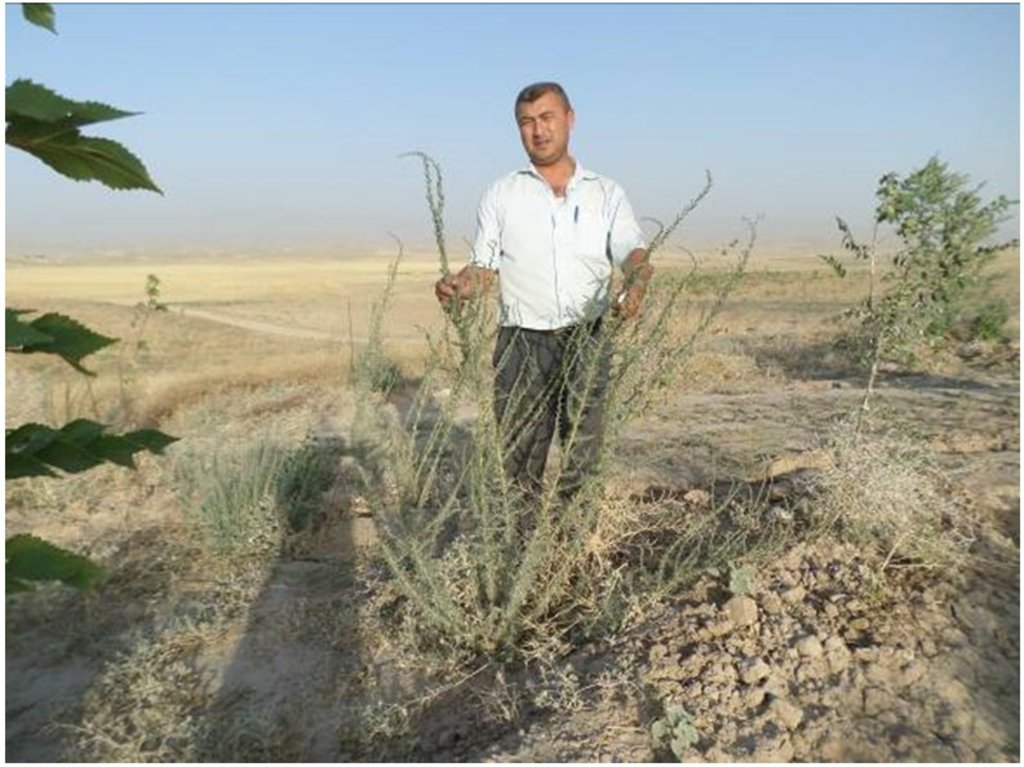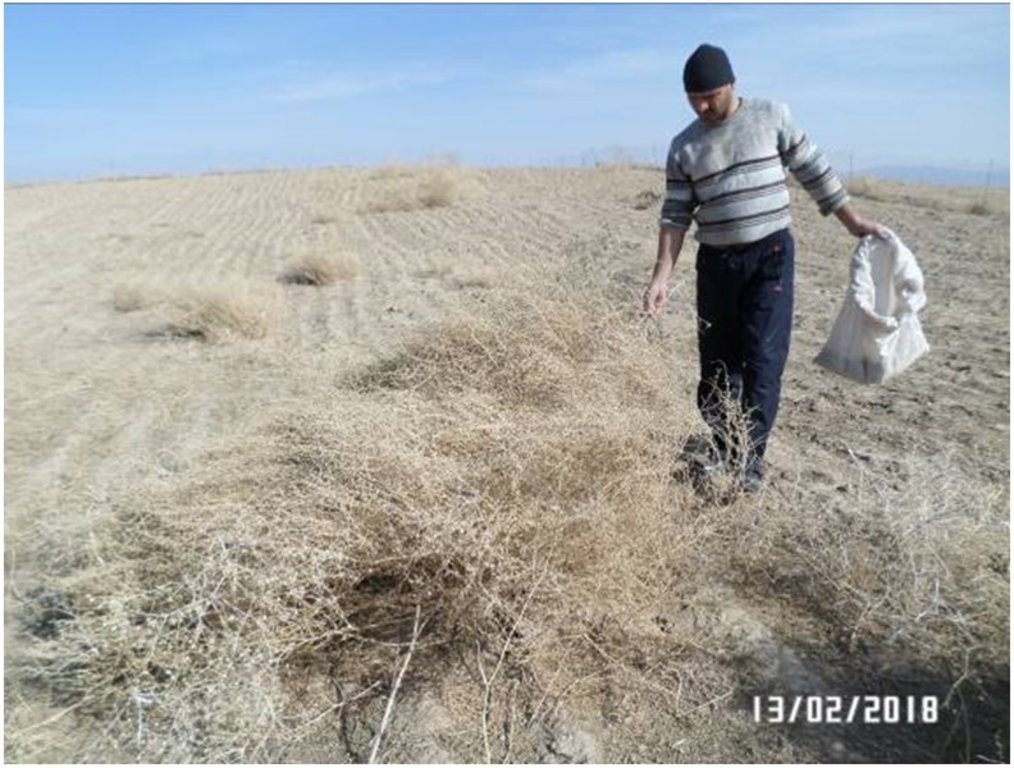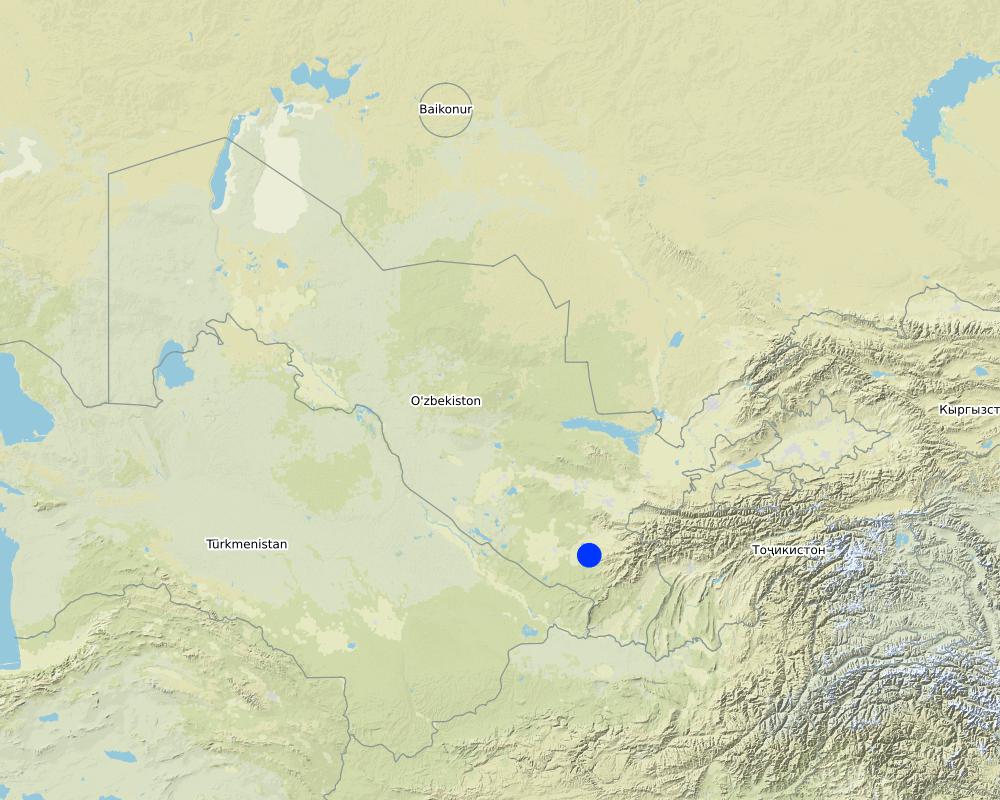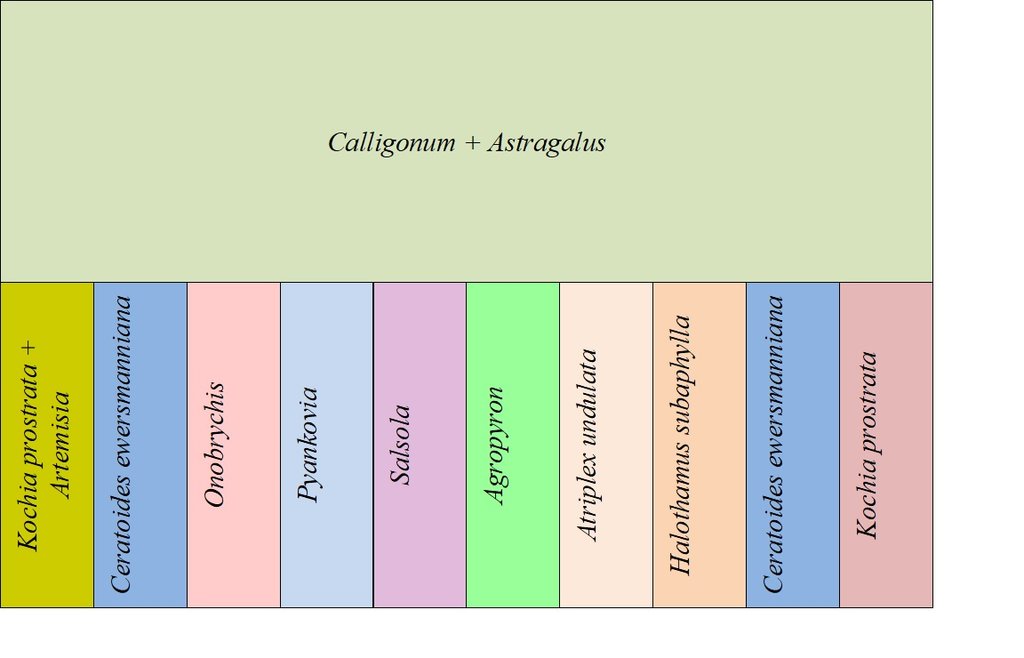Выращивание пустынных засухоустойчивых культур на богаре для повышения кормопроизводства и предотвращения эрозии [أوزبكستان]
- تاريخ الإنشاء:
- تحديث:
- جامع المعلومات: Rustam Ibragimov
- المحرر: –
- المراجعون: Alexandra Gavilano, Elizaveta Soloveyva, Olga Andreeva
Выращивание пустынных засухоустойчивых культур на богаре для повышения кормопроизводства и предотвращения эрозии
technologies_3650 - أوزبكستان
- Выращивание пустынных засухоустойчивых культур на богаре для повышения кормопроизводства и предотвращения эрозии: 11 سبتمبر، 2018 (inactive)
- Выращивание пустынных засухоустойчивых культур на богаре для повышения кормопроизводства и предотвращения эрозии: 22 أغسطس، 2019 (inactive)
- Выращивание пустынных засухоустойчивых культур на богаре для повышения кормопроизводства и предотвращения эрозии: 21 يناير، 2020 (public)
عرض الأقسام
توسيع الكل طي الكل1. معلومات عامة
1.2 تفاصيل الاتصال بالأشخاص الرئيسيين لمصدر المعلومات والمؤسسات المشاركة في تقييم وتوثيق التقنية
الشخص (الأشخاص) الرئيسي لمصدر المعلومات
متخصص في الإدارة المستدامة للأراضي:
Мукимов Толибжон, Худайкулович
Научно-исследовательский институт каракулеводства и экологии пустынь
أوزبكستان
اسم المشروع الذي سهّل توثيق/تقييم التقنية (إذا كان ذلك على صلة)
Decision Support for Mainstreaming and Scaling out Sustainable Land Management (GEF-FAO / DS-SLM)اسم المؤسسة (المؤسسات) التي سهلت توثيق/تقييم التقنية (إذا كان ذلك على صلة)
Design and Research UZGIP Institute, Ministry of Water Resources (UzGIP) - أوزبكستان1.3 الشروط المتعلقة باستخدام البيانات الموثقة من خلال WOCAT
يوافق جامع المعلومات والشخص (لاشخاص) الرئيسي لمصدر المعلومات على الشروط المتعلقة باستخدام البيانات الموثقة من خلال WOCAT:
نعم
1.4 إعلان بشأن استدامة التقنية الموصوفة
هل التقنية الموصوفة هنا تمثل مشكلة فيما يتعلق بتدهور الأراضي، بحيث لا يمكن إعلانها تقنية مستدامة لإدارة الأراضي؟:
كلا
2. وصف تقنيةالإدارة المستدامي للأراضي
2.1 وصف مختصر للتقنية
تعريف التقنية:
Выращивание пустынных кормовых растений в богарных условиях обеспечивает адаптацию к засухе, создает кормовые запасы для животноводства и предотвращает развитие водной эрозии
2.2 وصف تفصيلي للتقنية
الوصف:
Для населения, проживающего в богарной зоне, животноводство является основным источником жизнеобеспечения и благополучия, доля которого в семейном бюджете составляет 80-95%. Поэтому, создание прочной кормовой базы, способной обеспечить развитие животноводства и решить проблему сохранения биоразнообразия при удовлетворении жизненных потребностей населения, является основной задачей. Урожайность богарных пастбищ в Узбекистане находится в большой зависимости от погодных условий и резко меняется по годам и сезонам (от 1,5-2,0 до 5 ц/га). Не рациональное использование пастбищ, слабое применение мероприятий по восстановлению деградированных участков, а также ряд других факторов обусловили значительное увеличение антропогенной нагрузки на пастбища, что способствовало их деградации. Выращивание пустынных кормовых растений на богаре, таких как изен (Kochia prostrata), чогон (Halothamus subaphylla), терескен (Ceratoides Ewersmanniana), атриплекс (Atriplex undulata) и др., максимально приспособленных к почвенной и воздушной засухе, позволит создать дополнительные кормовые запасы, снизить нагрузку на пастбища и обеспечить сбалансированное питание животных. В первый год вегетации урожайность пустынных растений составляет 1,5- 1,6 ц/га сухой массы, во второй год - 2,2-3,5 ц/га сухой кормовой массы и около 0,4 ц/га семян; в третий год 8-12 ц/га сухой массы и 1,0-1,2 ц/га семян. При правильном использовании семенных посевов и пастбищных агрофитоценозов данные растительные сообщества способны само восстанавливаться в течение 20-35 лет.
Мероприятия и вклады на введение/содержание:Для расширения технологии на богаре необходимо создавать питомники первичного семеноводства, чтобы обеспечить семенами землепользователей. Технология выращивания пустынных растений включает вспашку на глубину 20-22 см, боронование, малование и сев с заделкой семян боронованием. Посев проводят в декабре – феврале нормой высева 12-15 кг/га, глубина заделки семян - 0,5-2 см. Уборку семян проводят в октябре-ноябре. Семена очищают, сушат и хранят при влажности не более 12%. При правильном способе хранения семена не теряют всхожесть в течение 6-9 месяцев после уборки. Для создания питомников первичного семеноводства на богаре требует порядка 700 000-850 000 сум/га (в пределах 100 долл.США/га).
Природная/социальная среда: Особенностью богарных условий на территории применения технологии является низкая обеспеченность осадками и подверженность почв водной и ветровой эрозии. Для повышения продуктивности богары в настоящее время расширяются площади под засухоустойчивыми видами культур, такими, как софлор. Поиск альтернативных решений и поддержка местного сообщества, основное занятие которого богарное земледелие и скотоводство, имеет первостепенное значение для повышения уровня жизни и благосостояния. Создание посевов из многолетних пустынных кормовых растений для кормопроизводства обеспечивает поддержку скотоводов и земледельцев. Технология предоставляет экологические выгоды, содействует смягчению воздействия изменения климата путем секвестрации СО2 в биомассе растений и почве (до 480 кг/га) и способствует общему оздоровлению окружающей среды.
2.3 صور التقنية
2.5 البلد/المنطقة/المواقع التي تم تنفيذ التقنية فيها والتي يغطيها هذا التقييم
البلد:
أوزبكستان
المنطقة/الولاية/المحافظة:
Камашинский район, Кашкадарьинская область
مزيد من التفاصيل حول الموقع:
г. Камаши
حدد انتشار التقنية:
- يتم تطبيقها في نقاط محددة/ تتركز على مساحة صغيرة
التعليقات:
эксперимент и адаптация технологии выполняется на деградированных землях богарной зоны площадью 1 гектар
Map
×2.6 تاريخ التنفيذ
اذكر سنة التنفيذ:
2015
في حالة عدم معرفة السنة بالتحديد، يرجى الإشارة إلى التاريخ التقريبي:
- منذ أقل من 10 سنوات (مؤخرًا)
2.7 إدخال التقنية
حدد كيف تم إدخال التقنية:
- من خلال المشاريع/ التدخلات الخارجية
التعليقات (نوع المشروع، الخ):
Эксперименты и исследования проведены учеными Узбекистана 30 лет назад. Внедрена технология в рамках Проекта ГЭФ/ФАО/ВОКАТ «Поддержка решений для продвижения и распространения устойчивого управления земельными ресурсами (DS-SLM) (2016-2018)
3. تصنيف تقنية الإدارة المستدامي للأراضي
3.1 الغرض الرئيسي ( الأغراض الرئيسية) للتقنية
- تحسين الإنتاج
- الحد من تدهور الأراضي ومنعه وعكسه
- الحفاظ على/تحسين التنوع البيولوجي
- التكيف مع تغير المناخ/الظواهر المتطرفة وآثارها
- التخفيف من تغير المناخ وآثاره
- خلق أثر اقتصادي مفيد
- Создание базы кормопроизводства и гарантированных кормовых запасов для домашнего скота с целью повышения продуктивности скота и снижения нагрузки на пастбища
3.2 نوع (أنواع) استخدام الأراضي الحالية حيث يتم تطبيق التقنية

أراضي الرعي
الرعي الواسع النطاق:
- رعي شبه مرتحل
- Полукочевое/ отгонное животноводство, Поголовье скота на единицу площади (если применимо): 2 головы на 1 гектар
- Мелкий и крупный рогатый скот - шерсть, мясо, молоко
التعليقات:
Сельхозполя (пахотные угодья) и плантации: деградированные земли богарной зоны, на которых прежде возделывались зерновые
3.4 إمدادات المياه
إمدادات المياه للأرض التي يتم تنفيذ التقنية عليها:
- بعلية
التعليقات:
Число урожаев за год:
2
Поясните:
2 укоса кормовых культур (весной и осенью)
3.5 مجموعةالإدارة المستدامة للأراضي التي تنتمي إليها هذه التقنية
- الإدارة المتكاملة للمحاصيل والثروة الحيوانية
- تحسين الغطاء الأرضي/النباتي
3.6 التدابير التقنية في مجال إلادارة المستدامة للأراضي

التدابير الزراعية
- A1: الغطاء النباتي/التربة

التدابير النباتية
- V2: الأعشاب والنباتات العشبية المعمرة

التدابير الإدارية
- M1: التغيير في نوع استخدام الأراضي
3.7 الأنواع الرئيسية من تدهور الأراضي التي تناولتها التقنية

تآكل التربة بالمياه
- الوزن(Wt): فقدان التربة السطحية/تآكل السطح

تآكل التربة الناتج عن الرياح
- (Et): فقدان التربة السطحية

التدهور البيولوجي
- (Bc): تناقص الغطاء النباتي
التعليقات:
Природные причины деградации: необеспеченность осадками богарной зоны земледелия, ветровая и водная эрозия на склонах;
антропогенная: отсутствие полезащитных лесополос, несоответствующая агротехника обработки почвы, не применяются различные приемы и способы, снижающие испарение с поверхности почвы и повышающие влагонакопление, недостаточное разнообразие засухоустойчивых сортов и видов культурных растений и др.
3.8 منع أو حد أو عكس تدهور الأراضي
تحديد هدف التقنية فيما يتعلق بتدهور الأراضي:
- الحد من تدهور الأراضي
- اصلاح/إعادة تأهيل الأراضي المتدهورة بشدة
التعليقات:
Повышение продуктивности земель, за счет интенсивных культур и включения в травостой бобовых трав, повышение биоразнообразия
4. المواصفات الفنية، وأنشطة التنفيذ، والمدخلات، والتكاليف
4.1 الرسم الفني للتقنية
المواصفات الفنية (المتعلقة بالرسم الفني):
Посев пустынных засухоустойчивых растений на участке выполняется полосами шириной 5 м с чередованием различных видов. сев проводят нормой 12-15 кг/га, заделка семян осуществляется боронованием или малованием на глубину 0,5-2 см. Такая схема сева обеспечивает биологическое разнообразие и оптимальную плотность растительного покрова.
المؤلف:
T. Mukimov
4.2 معلومات عامة بخصوص حساب المدخلات والتكاليف
حدد كيفية احتساب التكاليف والمدخلات:
- حسب مساحة تنفيذ التقنية
الإشارة إلى حجم ووحدة المساحة:
1 гектар
حدد العملة المستخدمة لحساب التكاليف:
- دولار أمريكي USD
إذا كان ذا صلة، وضح سعر الصرف من الدولار الأمريكي إلى العملة المحلية (على سبيل المثال، 1 دولار أمريكي = 79.9 ريال برازيلي): 1 دولار أمريكي =:
4150,0
اذكر متوسط تكلفة أجر العمالة المستأجرة في اليوم الواحد:
4, 75 долл. США
4.3 أنشطة التأسيس
| النشاط | التوقيت (الموسم) | |
|---|---|---|
| 1. | Планировка, вспашка, малование, боронование | Зима- весна |
| 2. | Посев | Декабрь-февраль |
| 3. | Уход за посевами | Апрель-май |
| 4. | Укосы | Май-октябрь |
| 5. | Охрана участка | в течении вегетации |
التعليقات:
Мероприятия по запуску технологии включают обычную агротехнику сева культур с соблюдением особенностей (глубина заделки, нормы высева семян и др.)
4.4 التكاليف والمدخلات اللازمة للتأسيس
| تحديد المدخلات | الوحدة | الكمية | التكاليف لكل وحدة | إجمالي التكاليف لكل مدخل | % من التكاليف التي يتحملها مستخدمو الأراضي | |
|---|---|---|---|---|---|---|
| العمالة | Труд рабочего по посадке | долл. США/га | 1,0 | 60,0 | 60,0 | |
| معدات | Использование механизации при севе | долл. США/га | 1,0 | 21,0 | 21,0 | |
| المواد النباتية | Семена пустынных растений | долл. США/га | 1,0 | 40,0 | 40,0 | |
| مواد البناء | Огораживание участка | долл. США/га | 1,0 | 200,0 | 200,0 | |
| إجمالي تكاليف إنشاء التقنية | 321,0 | |||||
| إجمالي تكاليف إنشاء التقنية بالدولار الأمريكي | 0,08 | |||||
إذا تحمل مستخدم الأرض أقل من 100% من التكاليف، حدد من قام بتغطية التكاليف المتبقية:
проектом
4.5 الصيانة/الأنشطة المتكررة
| النشاط | التوقيت/الوتيرة | |
|---|---|---|
| 1. | Уход за посевами | вегетация |
| 2. | Укосы | 2- раза в период цветения и плодоношения |
| 3. | Охрана участка | в течение вегетации |
4.6 التكاليف والمدخلات اللازمة للصيانة/للأنشطة المتكررة (سنويًا)
| تحديد المدخلات | الوحدة | الكمية | التكاليف لكل وحدة | إجمالي التكاليف لكل مدخل | % من التكاليف التي يتحملها مستخدمو الأراضي | |
|---|---|---|---|---|---|---|
| العمالة | Труд рабочего по уходу за посевами | долл. США/га | 1,0 | 60,0 | 60,0 | 100,0 |
| المواد النباتية | Укосы | долл. США/га | 1,0 | 40,0 | 40,0 | 100,0 |
| إجمالي تكاليف صيانة التقنية | 100,0 | |||||
| إجمالي تكاليف صيانة التقنية بالدولار الأمريكي | 0,02 | |||||
إذا لم تتمكن من تفصيل التكاليف في الجدول أعلاه، قدم تقديرًا للتكاليف الإجمالية لصيانة التقنية:
100,0
4.7 أهم العوامل المؤثرة على التكاليف
قدم وصفا لأهم العوامل التي تؤثر على التكاليف:
Наибольшие затраты в первый год реализации технологии относятся к закупке семян и огораживанию участка от потравли скотом
5. البيئة الطبيعية والبشرية
5.1 المناخ
هطول الأمطار السنوي
- < 250 مم
- 251- 500 ملم
- 501 - 750ملم
- 1,000-751 ملم
- 1,500-1,100 ملم
- 2,000-1,500 ملم
- 3,000-2,001 ملم
- 4,000-3,100 ملم
- > 4000 ملم
حدد متوسط هطول الأمطار السنوي (إذا كان معروفًا)، بالملليمتر:
120,00
المواصفات/التعليقات على هطول الأمطار:
сумма осадков, 90% осадков приходится на октябрь-май
الإشارة إلى اسم محطة الأرصاد الجوية المرجعية المعنية:
Камаши
المنطقة المناخية الزراعية
- شبه قاحلة
Продолжительность вегетационного периода естественной растительности составляет 90-100 дней
5.2 طوبوغرافيا
متوسط الانحدارات:
- مسطح (0-2%)
- بسيط (3-5%)
- معتدل (6-10%)
- متدحرج (11-15%)
- تلال (16-30%)
- شديدة الانحدار(31-60%)
- فائقة الانحدار (>60%)
التضاريس:
- هضاب/سهول
- أثلام مرتفعة
- المنحدرات الجبلية
- منحدرات التلال
- منحدرات في السفوح
- قاع الوادي
المنطقة الارتفاعية:
- 100-0 متر فوق سطح البحر
- 500-101 متر فوق سطح البحر
- 1,000-501 متر فوق سطح البحر
- 1,500-1,001 متر فوق سطح البحر
- 2,000-1,501 متر فوق سطح البحر
- 2,500-2,100 متر فوق سطح البحر
- 3,000-2,501 متر فوق سطح البحر
- 4,000-3,001 متر فوق سطح البحر
- > 4000 متر فوق سطح البحر
وضح ما إذا كانت التقنية مطبقة على وجه التحديد في:
- غير ذات صلة
5.3 التربة
متوسط عمق التربة:
- ضحل جدًا (0-20 سم)
- ضحلة (21-50 سم)
- متوسطة العمق (51-80 سم)
- عميقة (81-120 سم)
- عميقة جدًا (> 120 سم)
قوام التربة (التربة السطحية):
- متوسط ( طميي، سلتي)
قوام التربة (> 20 سم تحت السطح):
- ناعم/ثقيل (طيني)
المواد العضوية في التربة السطحية:
- منخفضة (<1%)
5.4 توافر المياه ونوعيتها
منسوب المياه الجوفية:
50-5 م
توافر المياه السطحية:
ضعيف/ غير متوافر
نوعية المياه (غير المعالجة):
مياه شرب جيدة
هل تعتبر ملوحة الماء مشكلة؟:
كلا
هل تحدث فيضانات في المنطقة؟:
كلا
تعليقات ومواصفات أخرى بشأن نوعية المياه وكميتها:
Кормовые культуры выращиваются без орошения
5.5 التنوع البيولوجي
تنوع الأنواع:
- منخفض
تنوع الموائل:
- منخفض
التعليقات والمواصفات الإضافية بشأن التنوع البيولوجي:
Растительность богары представлена в основном культурными растениями (оз.пшеница, софлор). После уборки поверхность земли пересыхает и остается без растительности вследствие отсутствия осадков
5.6 خصائص مستخدمي الأراضي الذين يطبقون التقنية
مستقر أو مرتحل:
- غير المترحل
التوجه السوقي لنظام الإنتاج:
- مختلط (كفاف/ تجاري)
الدخل من خارج المزرعة:
- >50% من إجمالي الدخل
المستوى النسبي للثروة:
- متوسط
أفراداً أو مجموعات:
- تعاونية
مستوى المكننة:
- ميكانيكية/ مزودة بمحرك
الجنس:
- رجال
عمر مستخدمي الأرضي:
- متوسط العمر
5.7 متوسط مساحة الأرض التي يستخدمها مستخدمو الأراضي الذين يطبقون التقنية
- < 0.5 هكتارا
- 0.5 - 1 هكتار
- 1 -2 هكتار
- 2 - 5 هكتار
- 5 - 15 هكتار
- 15 - 50 هكتار
- 50 - 100هكتار
- 500-100 هكتار
- 1,000-500 هكتار
- 10,000-1,000 هكتار
- > 10,000 هكتار
هل يعتبر هذا نطاقًا صغيرًا أو متوسطًا أو واسعا (في إشارة إلى السياق المحلي)؟:
- على نطاق متوسط
5.8 ملكية الأراضي، وحقوق استخدام الأراضي، وحقوق استخدام المياه
ملكية الارض:
- دولة
- فردية، يوجد سند ملكية
حقوق استخدام الأراضي:
- مؤجر
حقوق استخدام المياه:
- فردي
- Вода для питья в основном привозная из-за отсутствия поверхностных источников и глубокого залегания подземных вод. Оросительная вода отсутствует
5.9 الوصول إلى الخدمات والبنية التحتية
الصحة:
- ضعيف
- معتدل
- جيد
التعليم:
- ضعيف
- معتدل
- جيد
المساعدة التقنية:
- ضعيف
- معتدل
- جيد
العمل (على سبيل المثال خارج المزرعة):
- ضعيف
- معتدل
- جيد
الأسواق:
- ضعيف
- معتدل
- جيد
الطاقة:
- ضعيف
- معتدل
- جيد
الطرق والنقل:
- ضعيف
- معتدل
- جيد
مياه الشرب وخدمات الصرف الصحي:
- ضعيف
- معتدل
- جيد
الخدمات المالية:
- ضعيف
- معتدل
- جيد
6. الآثار والتصريحات الختامية
6.1 الآثار التي أظهرتها التقنية في الموقع
الآثار الاجتماعية والاقتصادية
الإنتاج
إنتاج الأعلاف
جودة العلف
الدخل والتكاليف
النفقات على المدخلات الزراعية
دخل المزرعة
التعليقات/ حدد:
2,5 млн. сум чистого дохода
عبء العمل
الآثار الايكولوجية
التربة
تراكم التربة
التنوع البيولوجي: الغطاء النباتي، الحيوانات
الغطاء النباتي
الكتلة الحيوية/ طبقة الكربون فوق التربة
التنوع النباتي
الحد من مخاطر المناخ والكوارث
آثار الجفاف
المناخ الموضعي (مايكرو)
6.2 الآثار التي أظهرتها التقنية خارج الموقع
آثار الغازات الدفيئة
قيّم الآثار خارج الموقع (القياسات):
Технология не оказывает отрицательного влияния на окружающую среду, некоторые виды бобовых улучшают почву, увеличивается биоразнообразие, за счет полночленности созданного ярусного фитоценоза (кустарники, полукустарники, травы) и развития под покровом травянистой растительности.
6.3 تعرض التقنية وحساسيتها لتغير المناخ التدريجي والظواهر المتطرفة/الكوارث المرتبطة بالمناخ (كما يراها مستخدمو الأراضي)
تغير مناخ تدريجي
تغير مناخ تدريجي
| الموسم | زيادة أو نقصان | كيف تتعامل التقنية مع ذلك؟ | |
|---|---|---|---|
| درجة الحرارة السنوية | زيادة | جيدة جدا | |
| درجة الحرارة الموسمية | الصيف | زيادة | جيدا |
| هطول الأمطار السنوي | انخفاض | جيدا | |
| هطول الأمطار الموسمية | الربيع | انخفاض | جيدا |
| هطول الأمطار الموسمية | الصيف | انخفاض | جيدا |
الظواهر المتطرفة / الكوارث المرتبطة بالمناخ
الكوارث المناخية
| كيف تتعامل التقنية مع ذلك؟ | |
|---|---|
| موجة حر | جيدا |
| جفاف | جيدا |
العواقب الأخرى المتعلقة بالمناخ
العواقب الأخرى المتعلقة بالمناخ
| كيف تتعامل التقنية مع ذلك؟ | |
|---|---|
| فترة نمو ممتدة | جيدة جدا |
6.4 تحليل التكلفة والعائد
كيف يمكن مقارنة العوائد نسبة لتكاليف الإنشاء (من وجهة نظر مستخدمي الأراضي)؟
عوائد قصيرة الأجل:
إيجابي قليلا
عوائد طويلة الأجل:
إيجابي
كيف تتم مقارنة العوائدمع كلفة الصيانة/التكاليف المتكررة (من وجهة نظر مستخدمي الأراضي)؟
عوائد قصيرة الأجل:
إيجابي قليلا
عوائد طويلة الأجل:
إيجابي
التعليقات:
Краткосрочные положительные выгоды: Повышение урожайности и обеспечение полноценным гарантированным кормом скота в осенне-зимний период. Долгосрочные положительные выгоды: сохранение и повышение биоразнообразия , снижение нагрузки на пастбища
6.5 اعتماد التقنية
- 11-50%
من بين جميع الذين تبنوا التقنية، كم عدد الذين فعلوا ذلك بشكل تلقائي، أي دون تلقي أي حوافز مادية/مدفوعات؟:
- 11-50%
6.6 التكيف
هل تم تعديل التقنية مؤخرًا لتتكيف مع الظروف المتغيرة؟:
كلا
6.7 نقاط القوة / المزايا / الفرص التي توفرها التقنية
| نقاط القوة/ المزايا/ الفرص من وجهة نظر مستخدمي الأراضي |
|---|
| Получение дополнительного корма для скота |
| Дополнительный источник дохода |
| Низкий уровень вложений в технологию |
| نقاط القوة/ المزايا/ الفرص من وجهة نظر جامع المعلومات أو غيره من الاشخاص الرئيسيين لمصدر المعلومات |
|---|
| Не требует специальных вложений во внедрение технологии |
| Быстрое получение доходов; с каждого гектара на третий год до 2,5 млн. сум чистого дохода, на 4 год до 3,5 млн. сум за счет реализации семян и использования сена |
6.8 نقاط ضعف / مساوىء / مخاطر التقنية وسبل التغلب عليها
| نقاط الضعف/ المساوىء/ المخاطر من وجهة نظر مستخدم الأراضي | كيف يمكن التغلب عليها؟ |
|---|---|
| Отсутствие широкой информации о возможности применения технологии | пропаганда |
| Отсутствие семенного материала пустынных трав |
| نقاط الضعف/ المساوىء/ المخاطر من وجهة نظر جامع المعلومات أو غيره من الاشخاص الرئيسيين لمصدر المعلومات | كيف يمكن التغلب عليها؟ |
|---|---|
| В условиях богары низкая всхожесть семян пустынных трав (гарантированные всходы можно получать 1 раз в 3-4 года) | Использование рекомендаций и новых технологий посева |
7. المراجع والروابط
7.1 طرق جمع/مصادر المعلومات
- زيارات ميدانية، مسوحات ميدانية
Сентябрь, 2015-2017
- مقابلات مع مستخدمي الأراضي
опрошено 6 чел
- مقابلات مع المتخصصين/الخبراء في الإدارة المستدامة للأراضي
3 чел
- التجميع من التقارير والوثائق الأخرى الموجودة
Отчетов и технологий ИКАРДА, ИКБА, НИИКЭП, GIZ
متى تم تجميع البيانات (ميدانيا)؟:
21/11/2016
7.2 المراجع للمنشورات المتاحة
العنوان، المؤلف، السنة، النظام القياسي الدولي لترقيم الكتب ISBN:
Мукимов Т. и др. Современное состояние предгорных пастбищ Фаришского района и участие местного населения в их использовании и восстановлении. 2013
متاح من أين؟كم التكلفة؟:
Сборник научно-практической конференции. Ташкент
العنوان، المؤلف، السنة، النظام القياسي الدولي لترقيم الكتب ISBN:
Хамзина Т.И. и др. ПРАКТИКИ И ТЕХНОЛОГИИ ДЛЯ УСТОЙЧИВОГО ИСПОЛЬЗОВАНИЯ ОРОШАЕМЫХ И БОГАРНЫХ ЗЕМЕЛЬ, ПОДВЕРЖЕННЫХ ЗАСОЛЕНИЮ И ЗАСУХЕ 2017
متاح من أين؟كم التكلفة؟:
Сборник научно-практической конференции. Ташкент
العنوان، المؤلف، السنة، النظام القياسي الدولي لترقيم الكتب ISBN:
Mukimov T/ Uzbekistan -- Rangelands and Pasturelands: Problems and Prospects 2017
متاح من أين؟كم التكلفة؟:
Adelaide, Australia, NOVA
الروابط والوحدات المواضيعية
توسيع الكل طي الكلالروابط
لا يوجد روابط
الوحدات المواضيعية
لا يوجد وحدات مواضيعية


